The impact of global food prices on inflation in times of Covid-19
How much of consumer price inflation in Latvia is determined by global food commodity price developments?
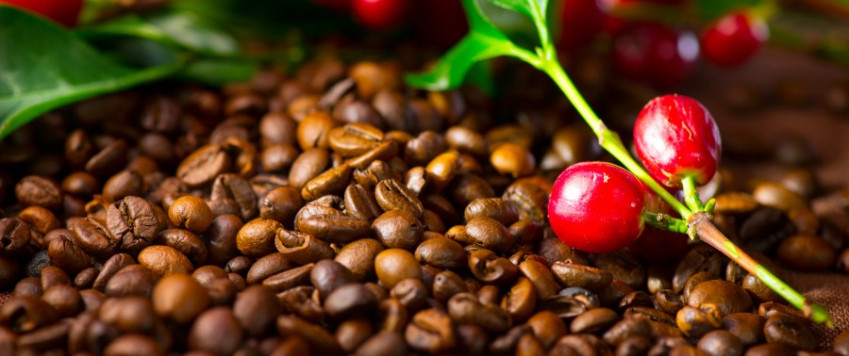
Recently some media have been pointing to the soaring global food commodity prices and even voicing concerns that the world might be standing on the brink of a food crisis. Should we expect a sharp rise in global and consumer food prices or is such a view just an echo of the 'information noise' coming from market speculators?
A year ago, we studied the pass-through of global food commodity prices to consumer prices in Latvia. We concluded that changes in global food commodity prices are an important factor affecting consumer price inflation in Latvia. An increase in global food commodity prices by 10% would raise the consumer price level in Latvia by 0.9% in three years. In this article, we re-examine the extent to which fluctuations in global food commodity prices determine Latvia's headline inflation and make an assessment of what we expect in 2020.
The prices of six main global food commodities
We have analysed developments in prices of six main global food commodities – cereals, meat, milk, fish, sugar and coffee – and assessed their impact on consumer price inflation in Latvia. In 2015-2016, global food commodity prices were a major factor behind the very low inflation, whereas in 2011 and 2017 they, quite to the opposite, contributed significantly to rising inflation. According to our estimates, the impact of global prices of food commodities on consumer price inflation in Latvia in 2020, however, is expected to be rather small (around 0.1 percentage point (pp.); Charts 1 and 2).
Chart 1. The impact of global food commodity prices on annual consumer price inflation in Latvia (pp.)
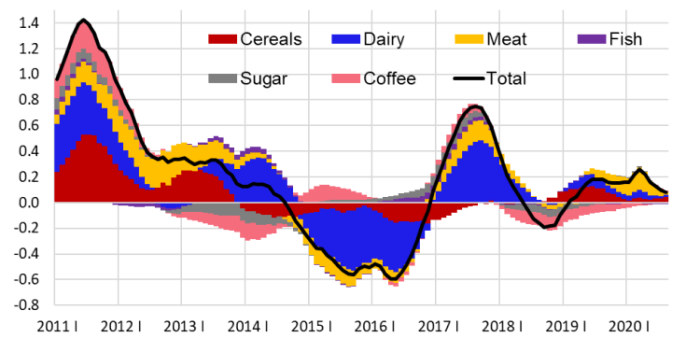
Note. The impact of global food commodity prices on consumer prices in Latvia is based on the Latvijas Banka Working Paper No. 1/2020 "Short-Term Inflation Projections Model and Its Assessment in Latvia".
Chart 2. The impact of global food commodity prices on consumer food prices and headline inflation in Latvia (pp.)
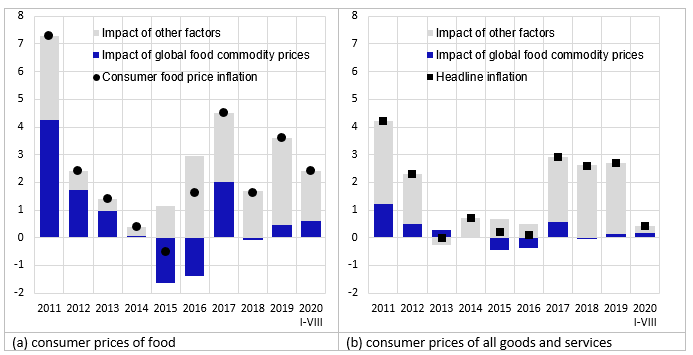
Note. The impact of global food commodity prices on consumer prices in Latvia is based on the Latvijas Banka Working Paper No. 1/2020 "Short-Term Inflation Projections Model and Its Assessment in Latvia".
Meat and fish
Consumer spending on meat products makes up almost 5% of the consumption basket in Latvia. The retail price of meat products closely follows the meat producer prices in the European Union (EU). Over the last decade, meat producer prices have been rising steadily –and this has led to an average annual increase in Latvian consumer prices of 0.06 pp. In 2019, the global supply of pork dropped due to the outbreak of swine fever in China. Against this background, the demand for EU-produced pork has increased. As a result, pork producer prices in the EU have risen significantly and pork prices have stabilised only recently. Global meat price developments may increase Latvia's inflation in 2020 by almost 0.1 pp. (Chart 3).
The impact of global fish prices on consumer prices in Latvia has never exceeded one tenth of a percentage point. First, global fish prices are highly volatile: after a few months (i.e. before the full pass-through to consumer prices takes place), sharp increases are followed by abrupt declines; thus, the full impact of the initial price increase may not even materialize. Second, spending on fish products in Latvia constitutes a relatively small share of the consumption basket (less than 1%). Hence, we expect the impact of global fish price developments on consumer prices in Latvia to be close to zero in 2020 (Chart 4).
Chart 3. Meat producer price index in the EU and its impact on headline inflation in Latvia
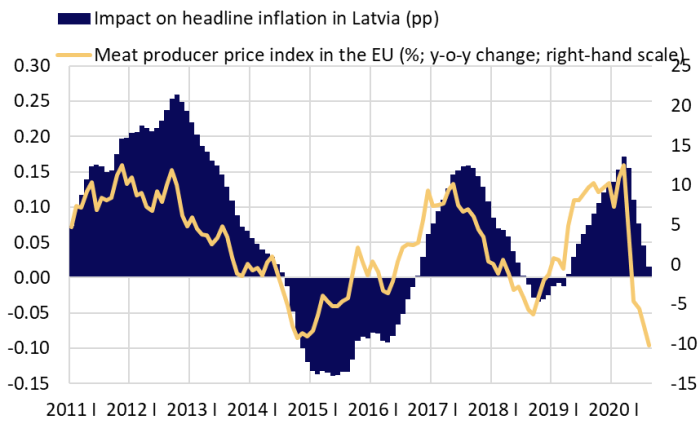
Note. Meat producer price index represents EU producer prices for beef, chicken and pork.
Chart 4. Global fish price index and its impact on headline inflation in Latvia
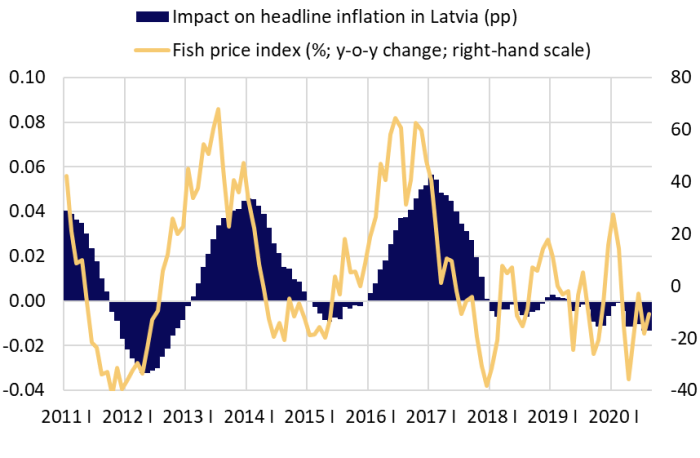
Note. Global fish price index represents Nasdaq salmon prices.
Cereals
EU producer prices for cereals appear to considerably affect Latvian consumer prices for cereal products, eggs and alcoholic beverages (which together account for 9% of the consumption basket).
Global cereal prices had a minor negative impact on Latvian consumer price inflation in 2014–2017 In the second half of 2018, however, global cereal prices were pushed up as a result of the dry and hot summer, thereby negatively affecting cereal yields in the European region. According to our estimates, this increased Latvia's inflation by 0.1 pp. in 2019. During 2019–2020, in contrast, the global cereal harvest was record high, having a downward effect on cereal prices. Currently, the global stocks of cereals have reached an all-time high. Therefore, one should not expect a major increase in cereal prices, even if some countries raise their cereal stocks to insure themselves against potential supply chain disruptions as a result of the Covid-19 outbreak. Hence, the impact of global cereal price changes on consumer price inflation in Latvia is expected to be close to the historical average in 2020 (0.06 pp.; Chart 5).
Chart 5. Cereal producer price index in the EU and its impact on headline inflation in Latvia
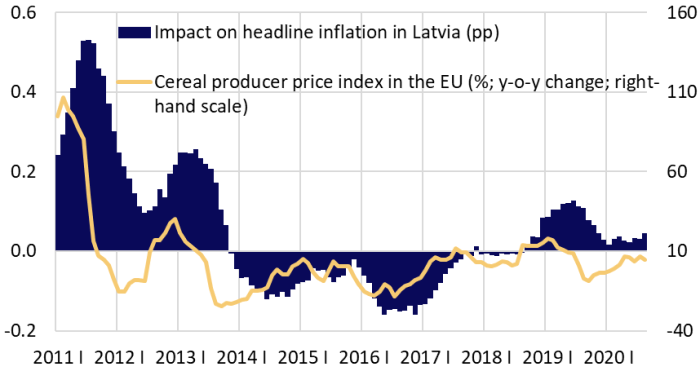
Note. Cereal producer price index represents EU producer prices for wheat, rye, barley, oats, maize and flour.
Dairy
Another important global food commodity is dairy products. EU dairy producer prices undoubtedly affect Latvian consumer prices for dairy products [1] (4% of the consumption basket). Over the last decade, we have witnessed large swings in global dairy prices. This fact was also mirrored in the developments of Latvia's dairy consumer prices. For example, falling global dairy prices reduced Latvia's inflation by 0.3 pp. in 2015 and 2016, while rising global dairy prices increased inflation by more than 0.3 pp. in 2017. Recent developments in EU dairy producer prices do not raise any large concerns (Chart 6). Hence the impact of global dairy prices on consumer price inflation in Latvia most likely will be as low as just some hundredths of a percentage point in 2020.
Chart 6. Dairy producer price index in the EU and its impact on headline inflation in Latvia
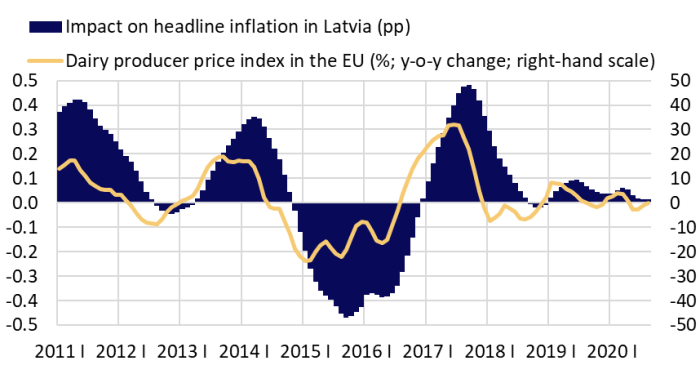
Note: Dairy producer price index represents EU producer prices for raw milk, whole milk powder, skimmed milk powder, butter and cheese.
Sugar
Consumer prices of sweets and "other food" prices (slightly above 2% of the consumption basket) depend on global sugar prices. The better the sugar cane harvest (which largely depends on the weather conditions) is, the lower the global sugar prices are. Due to the chemical properties of sugar, it is also used in bioethanol production. Hence, substitution effects are at play: high (low) crude oil prices entail increased (decreased) demand for sugar cane and therefore also a surge (decline) in global sugar prices.
Long expiry date of sugar determines a relatively slow pass-through of global prices to consumer prices. For example, despite an increase in global sugar prices in 2019, the impact of the global sugar price changes on consumer prices in Latvia was negative (reflecting the fall in the global sugar price in 2017-2018). In total, the impact of global sugar prices on consumer price inflation in Latvia is expected to be close to zero in 2020 (Chart 7).
Chart 7. Global sugar price index and its impact on headline inflation in Latvia
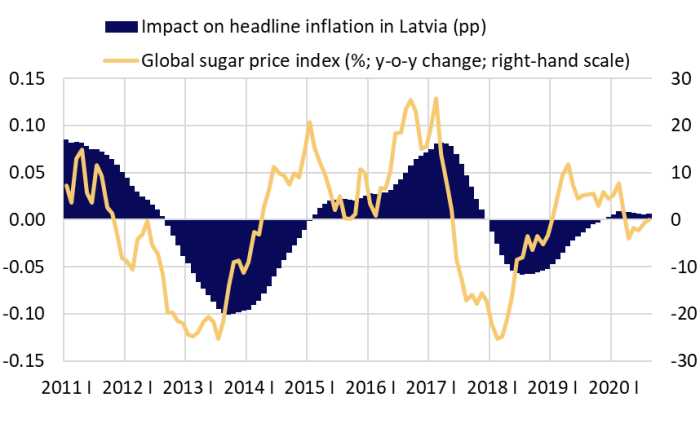
Coffee
Consumer spending on coffee purchases makes up about 1% of the average consumption basket in Latvia. The retail price of coffee in Latvia is quite closely linked to the world price of coffee beans. As in the case of sugar, Brazil is the largest producer and exporter of coffee; hence, the prices of both commodities are affected by weather conditions in Brazil and there is some synchronicity in price fluctuations. In addition, depreciation of the Brazilian national currency against the US dollar may temporarily shift coffee (and sugar) from domestic consumption to exports, thus lowering the world price.
Over the past two years, the impact of global coffee prices on consumer price inflation in Latvia has been negative, so we expect the impact rather to be close to zero in 2020 (Chart 8).
Chart 8. Global coffee price index and its impact on headline inflation in Latvia
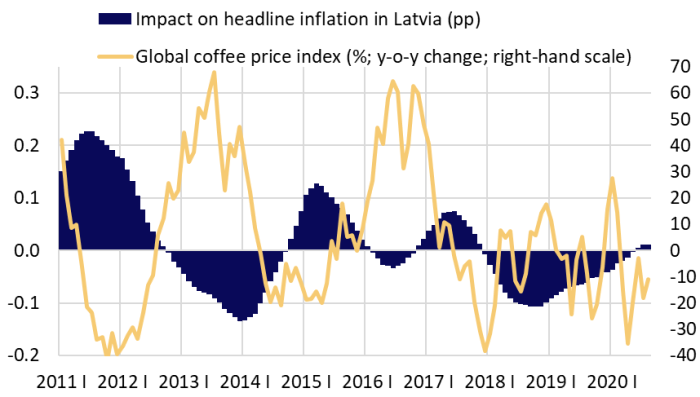
Conclusions
Our estimates show that the impact of global prices of food commodities on consumer price inflation in Latvia is expected rather small in 2020 (around 0.1 pp.; Charts 1 and 2).
Therefore, we do not see any grounds for a sharp increase in consumer food prices or a 'food crisis'. Particularly, the record-high cereal yields along with the record-high cereal stocks make such a radical price increase an implausible scenario, even if some countries do expand their cereal reserves. It means that consumer food prices in Latvia are likely to rise at a steady pace of about 2% per year, reflecting a gradual increase in labour costs.
In the past, we have, indeed, seen some instances when prices for specific food products have risen sharply due to particular events (for instance, the recently observed anomalously high demand for buckwheat has significantly increased its prices; or supply chain disruptions have pushed up prices of some imported fruits). Nonetheless, these increases are short-lived and are usually offset by price decreases in other groups of food products (cabbage, onions, butter, chicken etc.).
[1] Including butter, which, according to the Harmonized Index of Consumer Prices (HICP) classification, is included in a food component “oils and fats”.
Textual error
«… …»



